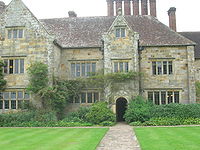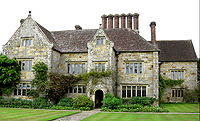
Bateman's
Encyclopedia

Burwash, East Sussex
Burwash is a rural village and civil parish in the Rother District of East Sussex, England. Situated fifteen miles inland from the South Coast port of Hastings, it is located five miles south-west of Hurst Green, on the A265 road, and on the River Dudwell, a tributary of the River Rother...
, East Sussex
East Sussex
East Sussex is a county in South East England. It is bordered by the counties of Kent, Surrey and West Sussex, and to the south by the English Channel.-History:...
, England
England
England is a country that is part of the United Kingdom. It shares land borders with Scotland to the north and Wales to the west; the Irish Sea is to the north west, the Celtic Sea to the south west, with the North Sea to the east and the English Channel to the south separating it from continental...
. British
United Kingdom
The United Kingdom of Great Britain and Northern IrelandIn the United Kingdom and Dependencies, other languages have been officially recognised as legitimate autochthonous languages under the European Charter for Regional or Minority Languages...
author Rudyard Kipling
Rudyard Kipling
Joseph Rudyard Kipling was an English poet, short-story writer, and novelist chiefly remembered for his celebration of British imperialism, tales and poems of British soldiers in India, and his tales for children. Kipling received the 1907 Nobel Prize for Literature...
lived in Bateman's from 1902 to his death in 1936. His wife left the house to the National Trust
National Trust for Places of Historic Interest or Natural Beauty
The National Trust for Places of Historic Interest or Natural Beauty, usually known as the National Trust, is a conservation organisation in England, Wales and Northern Ireland...
on her death in 1939, and it has since been opened to the public.
Exterior
Bateman's is a modest JacobeanJacobean architecture
The Jacobean style is the second phase of Renaissance architecture in England, following the Elizabethan style. It is named after King James I of England, with whose reign it is associated.-Characteristics:...
sandstone
Sandstone
Sandstone is a sedimentary rock composed mainly of sand-sized minerals or rock grains.Most sandstone is composed of quartz and/or feldspar because these are the most common minerals in the Earth's crust. Like sand, sandstone may be any colour, but the most common colours are tan, brown, yellow,...
mansion built in 1634 for a local ironmaster
Ironmaster
An ironmaster is the manager – and usually owner – of a forge or blast furnace for the processing of iron. It is a term mainly associated with the period of the Industrial Revolution, especially in Great Britain....
, John Brittan. Six brick columns form a massive central chimneystack above the gable
Gable
A gable is the generally triangular portion of a wall between the edges of a sloping roof. The shape of the gable and how it is detailed depends on the structural system being used and aesthetic concerns. Thus the type of roof enclosing the volume dictates the shape of the gable...
d facades.
Interior
Today the rooms are left as they were when the Kipling family lived there. Kipling and his wife created interiors that complemented the 17th-century house. The heart of the house is the book-lined study, at the top of the stairs, where Kipling worked. He sat at a 17th-century walnutWalnut
Juglans is a plant genus of the family Juglandaceae, the seeds of which are known as walnuts. They are deciduous trees, 10–40 meters tall , with pinnate leaves 200–900 millimetres long , with 5–25 leaflets; the shoots have chambered pith, a character shared with the wingnuts , but not the hickories...
refectory table
Refectory table
A refectory table is a highly elongated table used originally for dining in monasteries in Medieval times. In the Late Middle Ages the table gradually became a banqueting or feasting table in castles and other noble residences. The original table manufacture was by hand and created of oak or...
under the window and his writing tools, paperweight, and pipe are still there.
Bateman's also reflects Kipling's strong links with the Indian subcontinent
Indian subcontinent
The Indian subcontinent, also Indian Subcontinent, Indo-Pak Subcontinent or South Asian Subcontinent is a region of the Asian continent on the Indian tectonic plate from the Hindu Kush or Hindu Koh, Himalayas and including the Kuen Lun and Karakoram ranges, forming a land mass which extends...
. There are oriental rugs in many rooms and the parlour displays Kipling's collection of Indian works of art and artefacts. His bookplate
Bookplate
A bookplate, also known as ex-librīs [Latin, "from the books of..."], is usually a small print or decorative label pasted into a book, often on the inside front cover, to indicate its owner...
shows a small figure reading on top of an elephant
Elephant
Elephants are large land mammals in two extant genera of the family Elephantidae: Elephas and Loxodonta, with the third genus Mammuthus extinct...
. Exhibition rooms contain manuscripts, letters, and mementoes of Kipling's life and work.
History and setting for books

If—
"If—" is a poem written in 1895 by British Nobel laureate Rudyard Kipling. It was first published in the "Brother Square Toes" chapter of Rewards and Fairies, Kipling's 1910 collection of short stories and poems...
", "The Glory of the Garden", and Puck of Pook's Hill
Puck of Pook's Hill
Puck of Pook's Hill is a historical fantasy book by Rudyard Kipling, published in 1906, containing a series of short stories set in different periods of English history. The stories are all narrated to two children living near Burwash, in the area of Kipling's own house Bateman's, by people...
, named after the hill visible from the house. The house's setting and the wider local area features in many of his stories in Puck of Pook's Hill (1906).
Kipling's poem The Land is inspired by the Bateman's estate.
Bateman's was also used in the coloured 1966 edition of Tintin, 'The Black Island
The Black Island
The Black Island is the seventh of The Adventures of Tintin, a series of classic comic-strip albums, written and illustrated by Belgian writer and illustrator Hergé, featuring young reporter Tintin as the hero. It was first published in the newspaper supplement Le Petit Vingtième in the late 1930s...
' as the basis for the residence of Müller, the ex-Nazi antagonist. In the fictionalised adventure, the house is razed to the ground when a burning log from the hearth is used as a weapon during a scuffle.
Mill
There is a working watermill on the property using the waters of the River Dudwell, supported by volunteers. The mill raceMill race
A mill race, raceway or mill lade is the current or channel of a stream, especially one for conducting water to or from a water wheel or other device for utilizing its energy...
drives the waterwheel
Water wheel
A water wheel is a machine for converting the energy of free-flowing or falling water into useful forms of power. A water wheel consists of a large wooden or metal wheel, with a number of blades or buckets arranged on the outside rim forming the driving surface...
outside, and this in turn drives the wooden cogwheels
Gear
A gear is a rotating machine part having cut teeth, or cogs, which mesh with another toothed part in order to transmit torque. Two or more gears working in tandem are called a transmission and can produce a mechanical advantage through a gear ratio and thus may be considered a simple machine....
on the ground floor inside. These transfer power upstairs to the millstone
Millstone
Millstones or mill stones are used in windmills and watermills, including tide mills, for grinding wheat or other grains.The type of stone most suitable for making millstones is a siliceous rock called burrstone , an open-textured, porous but tough, fine-grained sandstone, or a silicified,...
s. One pair of millstones is encased in wood and has a bell to warn the miller when the corn in the hopper runs out. In the grinding process the corn keeps the millstones apart, preventing sparks and a fire risk. The bell has a strap which is held down by a full hopper of corn. When the hopper is nearly empty, the strap is released, thus ringing the bell.

